


JEAN INGRES 1780 -
xxxxxThe French neo-
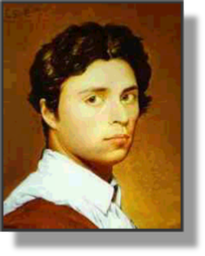 xxxxxThe French artist Jean Auguste Dominique Ingres, the most talented pupil of the neo-
xxxxxThe French artist Jean Auguste Dominique Ingres, the most talented pupil of the neo-
xxxxxIngres was born at Montauban, the son of an amateur artist and musician. He attended the Academy of Art in nearby Toulouse from 1791, and six years later entered the Paris studio of the great neo-
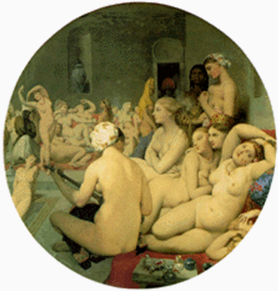 xxxxxHe eventually went to Rome in 1806, and remained studying and working there for fourteen years. He was particularly influenced by the work of the Italian painter Sanzio Raphael, to be seen especially in his balanced composition, clear lines and the coolness of his colours, and it was in these years that he gained a reputation as a remarkably accomplished draughtsman. To this period belongs two large historical canvases, produced in 1812, his The Dream of Ossian (thoroughly romantic, in fact, in subject and style), and Roger Freeing Angelica, based on a work by the Italian poet Ariosto, and the first of his famous oriental nudes, The Valpincon Bather of 1808, and La Grande Odalisque of 1814. This series of sensuous, idealized studies of the female body, full of grace and beauty despite some physical distortion, was enriched many years later by his two major works, Odalisque with Slave of 1842, and his circular masterpiece The Turkish Bath (illustrated), completed at the age of 82.
xxxxxHe eventually went to Rome in 1806, and remained studying and working there for fourteen years. He was particularly influenced by the work of the Italian painter Sanzio Raphael, to be seen especially in his balanced composition, clear lines and the coolness of his colours, and it was in these years that he gained a reputation as a remarkably accomplished draughtsman. To this period belongs two large historical canvases, produced in 1812, his The Dream of Ossian (thoroughly romantic, in fact, in subject and style), and Roger Freeing Angelica, based on a work by the Italian poet Ariosto, and the first of his famous oriental nudes, The Valpincon Bather of 1808, and La Grande Odalisque of 1814. This series of sensuous, idealized studies of the female body, full of grace and beauty despite some physical distortion, was enriched many years later by his two major works, Odalisque with Slave of 1842, and his circular masterpiece The Turkish Bath (illustrated), completed at the age of 82.
xxxxxIn 1814, however, with the collapse of the Napoleonic Empire, his own fortunes took a tumble. Lucrative commissions, mainly portraiture, quickly dried up, and he was forced to earn a living by making drawings of the countless English tourists who, now able to travel on the continent, flocked to Rome. He regarded such work as belittling but, in fact, these superb pencil drawings have proved almost without equal for their delicacy, their clarity of line, and their precise, accurate portrayal of character and social standing. In 1820 he moved to Florence. Here he painted a number of portraits and general scenes, but these only marginally improved his meagre income. As we have seen, it was not until 1824, on returning to Paris with his latest canvas, The Vow of Louis XIII -
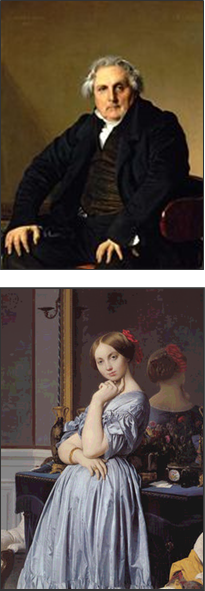
xxxxxSettled comfortably in Paris, it was in 1827 that he received one of his first major commissions, The Apotheosis of Homer, a beautiful painting for a ceiling in the Louvre. This truly marked him out as the champion of Classicism. Two years later he was appointed professor at the École des Beaux Arts, but criticism of his next work, the Martyrdom of St. Symphorian, prompted him to leave Paris. He returned to Rome in 1834 where he became director of the French Academy there, a post he held with distinction for seven years. One of his major works during that period was his Antiochus and Stratonice, a scene from the classical world which has not been surpassed for its detailed accuracy. Notable, too, was his brilliant portrait of Monsieur Bertin. Painted in 1832, and now in the Louvre, Paris, it is considered by many to be one of the finest portraits of the century (illustrated).
xxxxxIngres returned to Paris in 1841 and was given an enthusiastic welcome. He was wined and dined by many of his admirers, invited to dinner by King Louis Philippe, and the French composer Hector Berloz arranged a concert in his honour. The next 25 years were highly productive, and were noted above all for his highly detailed and refined portraits, amongst them being the delightful The Comtesse d’Haussonville in 1845 (illustrated), and Madame Moitessier in 1856. In 1853 he was commissioned to paint his Apotheosis of Napoleon I. Produced for the Town Hall in Paris (but destroyed in 1871), Napoleon III and the Empress Eugénie visited his studio to see the completed work.
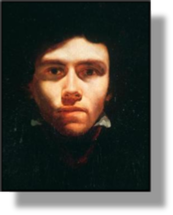 xxxxxThroughout his long career his work covered a wide variety of subjects. Apart from his beautiful nude studies and his brilliant portraits, he produced religious and historical paintings and covered a number of ceremonial functions. In all his work, his method of painting was painstakingly meticulous. He would make many preliminary copies in order to achieve the highest standard, being, as he himself put it, “incapable of any kind of compromise with bad taste”. And as a classicist he laid great stress on line and contour, sought to produce carefully balanced, two-
xxxxxThroughout his long career his work covered a wide variety of subjects. Apart from his beautiful nude studies and his brilliant portraits, he produced religious and historical paintings and covered a number of ceremonial functions. In all his work, his method of painting was painstakingly meticulous. He would make many preliminary copies in order to achieve the highest standard, being, as he himself put it, “incapable of any kind of compromise with bad taste”. And as a classicist he laid great stress on line and contour, sought to produce carefully balanced, two-
xxxxxIllustrated here are a drawing of the Italian violin virtuoso Nicolò Paganini, and his paintings: The Virgin of the Host, Madame Ingres, and Half-
Acknowledgements
Ingres: Self-
G4-
xxxxxHis preoccupation with line, and his preference for two-
xxxxxIncidentally, among his earlier works which were not too well received was his portrait of Emperor Napoleon, dressed in ermine and seated on his ceremonial throne. This work of 1806 was later dubbed 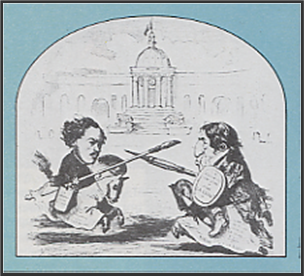 Napoleon mal-
Napoleon mal-
xxxxx…… His “battle” against Romanticism is illustrated here by way of a cartoon. On the right Ingres wields a fine pen in his fight for the “line”, whilst Delacroix supports “colour”, armed with a broad brush. ……
xxxxx…… Ingres was also an accomplished violinist and, during his second stay in Rome, he took part in a number of concerts. During these occasions he more than once accompanied the French composer Charles Gounod when he was playing the piano. His pencil drawing of the young composer, made in 1842, is now in the art institute of Chicago. So skilled was Ingres on the violin that the French expression violin d’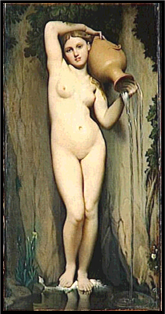 Ingres means a particular skill that a person practises in his or her spare time. ……
Ingres means a particular skill that a person practises in his or her spare time. ……
xxxxx…… When Ingres died in 1867 he bequeathed the contents of his studio to the Ingres Museum, which had been founded in his native city of Montauban in 1843. This included some 4,000 of his work drawings, sketches and studies, numerous paintings -
xxxxx…… His delight in portraying sensuous nudes has raised the suspicion that, pillar of the community though he was, Ingres was also something of a voyeur. Be that the case or not, we are indebted to him for producing some of the most beautiful paintings of the female form, as seen in this painting entitled La Source.



